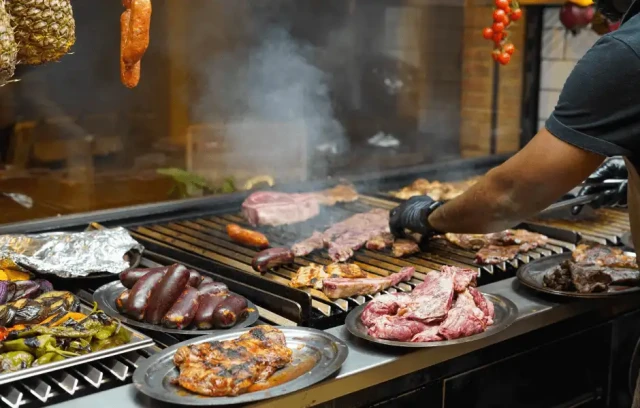In a bustling steakhouse, staffing plays a pivotal role in delivering an exceptional dining experience. The right team not only enhances customer satisfaction but also ensures seamless operations. Given the competitive nature of the restaurant industry, having skilled staff is crucial for a steakhouse to stand out. From chefs who perfect the art of cooking steaks to waitstaff providing impeccable service, expertise in every role is essential. Effective management and scheduling of these employees are vital for maintaining high standards. By leveraging advanced scheduling tools like RosterElf, steakhouses can ensure that they have the right people at the right time, ultimately leading to a memorable dining experience for their patrons. Efficient staff coordination not only boosts productivity but also creates a harmonious work environment, further contributing to the overall success of the steakhouse.
Key Roles in Steakhouse Staffing
Running a successful steakhouse requires a support team of skilled professionals working in harmony. From expert chefs who ensure each cut of meat is cooked to perfection to attentive front-of-house staff who provide exceptional customer service, every role is vital. Here, we detail the primary positions essential for a steakhouse, along with the common specific skills and qualifications required for each.

1. Expert Steakhouse Chefs
- Qualifications:
- Culinary degree or equivalent experience.
- Extensive knowledge of meat cuts and cooking techniques.
- Ability to maintain consistency in food quality.
- Responsibilities:
- Prepare and cook meats according to what customers expect and their preferences.
- Creating and refining steakhouse recipes.
- Overseeing kitchen operations and ensuring food safety standards.
- Contribution to Success:
- Ensure high-quality, delicious meals that keep customers returning, which will result in customer loyalty.
- Innovate and maintain a menu that reflects the steakhouse’s brand.
2. Kitchen Staff
- Qualifications:
- Basic culinary training or experience in a professional kitchen.
- Ability to work in a fast-paced environment.
- Knowledge of food safety and sanitation practices.
- Responsibilities:
- Assisting chefs in food preparation.
- Maintaining cleanliness and organisation in the kitchen.
- Managing inventory and ordering supplies.
- Contribution to Success:
- Support chefs in delivering high-quality meals efficiently.
- Ensure the kitchen operates smoothly.
3. Front-of-House Personnel
- Qualifications:
- Strong interpersonal and effective communication skills.
- Previous experience as a customer service representative or hospitality.
- Ability to handle stressful situations with poise.
- Responsibilities:
- Greeting and seating customers.
- Showcase the actual definition of a positive customer service team.
- Taking orders and serving food and beverages.
- Answer phone calls, manage reservations, and coordinate with kitchen staff.
- Contribution to Success:
- Create a welcoming and enjoyable dining experience for customers.
- Foster positive customer relations to build repeat business.
4. Management
- Qualifications:
- Experience in restaurant management or the hospitality industry.
- Strong leadership and organisational skills.
- Interested in the products and services of the business.
- Financial acumen and budgeting experience.
- Responsibilities:
- Overseeing daily operations of the steakhouse.
- Managing staff schedules and performance.
- Encourage the team to have positive and productive team dynamics, most especially during critical times.
- Ensuring compliance with health and safety regulations.
- Contribution to Success:
- Ensure smooth operation and profitability of the steakhouse.
- Lead and inspire the team to deliver exceptional service and quality.
Each role within a steakhouse is crucial to its overall success, ensuring that every aspect of the dining experience meets the highest standards. The seamless collaboration between the kitchen, front-of-house staff, and management is critical to creating a memorable experience for every guest.
Practical Training for Steakhouse Staff
Training programs are essential for the success of any steakhouse. Practical training not only equips new hires with the necessary skills but also ensures ongoing development for existing staff. Here are some best practices and valuable tips for restaurant owners to implement successful training programs:

- Hands-on Training: Engage new hires with hands-on experiences. Let them shadow experienced staff to learn the ropes of the job practically.
- Mentorship Programs: Pair new employees with seasoned team members who can give guidance, respond to inquiries, and provide support. This fosters a collaborative work environment.
- Continuous Education: Encourage ongoing learning through regular workshops and training sessions on customer service, menu knowledge, and health and safety standards.
- Use of Technology: Leverage RosterElf to efficiently organise training sessions, ensuring minimal disruption to daily operations.
- Menu Mastery: Ensure staff are well-versed in menu items, including ingredients, preparation methods, and presentation. This enhances customer satisfaction and promotes upselling.
- Customer Service Protocols: Regularly train staff on best practices for exceptional customer service, handling complaints, and creating a welcoming atmosphere.
- Health and Safety Standards: Emphasise team members who can offer guidance, address questions, and deliver training updates and practical drills.
Implementing these strategies will help maintain high standards, improve staff retention, and enhance the overall dining experience for customers.
Hiring Strategies for a Successful Steakhouse Team
Finding and hiring the right team is crucial for the success of any steakhouse. Practical strategies and best practices can streamline the process and ensure you bring on board talented individuals who are passionate about the industry. Here are some actionable tips for restaurant owners and managers:

Attracting Top Talent:
- Culinary Schools: Partner with local culinary schools to find candidates with formal training.
- Industry Job Boards: Use specialised job boards to reach experienced professionals.
- Networking: Leverage industry events and social media to connect with potential hires.
Interview Process:
- Key Questions: Ask about their previous experience, culinary skills, and passion for the industry.
- What to Look For: Evaluate their technical abilities, creativity, and teamwork skills.
Reference Checks:
- Always check references to verify work history and performance.
Trial Shifts:
- Conduct trial shifts to assess skills and fit with your existing team.
Cultural Fit:
- Ensure candidates align with your restaurant’s values and culture.
- Look for a genuine passion for the steakhouse industry, as it enhances employee engagement and customer satisfaction.
By following these best practices, you can build a unified team that plays a vital role in the success of your steakhouse.
Retention and Development Strategies for Steakhouse Staff
Retaining top-performing staff and fostering their development is crucial for the success of any steakhouse. Implementing effective strategies can ensure a motivated and loyal team, which is essential for delivering excellent customer service. Here are some critical approaches to achieve this:
- Competitive Compensation: Offer attractive wages and benefits to retain skilled employees.
- Positive Work Environment: Cultivate a supportive and engaging workplace culture through solid workforce management practices.
- Advancement Opportunities: Provide clear paths for career progression to keep employees motivated and invested in their roles.
- Recognition Programs: Implement recognition and reward programs to acknowledge hard work and dedication.
- Regular Feedback: Conduct consistent performance reviews and provide constructive feedback to help employees grow.
- Professional Development: Invest in training and development programs to enhance skills and career growth.
- Effective Scheduling: Utilise advanced scheduling tools like RosterElf to manage staff shifts efficiently, preventing burnout and ensuring work-life balance.
- Team Building Activities: Organise team-building events to strengthen camaraderie and team spirit.
Management plays a pivotal role in these strategies by creating a positive and nurturing work environment, ultimately leading to higher retention and development of steakhouse staff.

Ensuring the success of a steakhouse hinges on hiring and retaining skilled staff who deliver exceptional customer service. By utilising RosterElf and implementing the strategies discussed, you can build a solid and expert team dedicated to providing top-notch dining experiences. Emphasise continuous training, fostering a positive work environment, and efficient scheduling to keep your team motivated and effective.
To manage your steakhouse staffing needs effectively, consider leveraging advanced rostering tools and resources like RosterElf. These solutions can streamline your operations, enhance productivity, and ultimately improve customer satisfaction.
Visit RosterElf today and take action to optimise your staffing processes and set your steakhouse up for long-term success.



